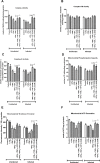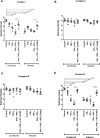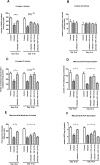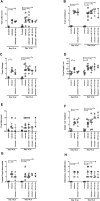Colonic levels of vasoactive intestinal peptide decrease during infection and exogenous VIP protects epithelial mitochondria against the negative effects of IFNγ and TNFα induced during Citrobacter rodentium infection
- PMID: 30252907
- PMCID: PMC6155558
- DOI: 10.1371/journal.pone.0204567
Colonic levels of vasoactive intestinal peptide decrease during infection and exogenous VIP protects epithelial mitochondria against the negative effects of IFNγ and TNFα induced during Citrobacter rodentium infection
Abstract
Citrobacter rodentium infection is a model for infection with attaching and effacing pathogens, such as enteropathogenic Escherichia coli. The vasoactive intestinal peptide (VIP) has emerged as an anti-inflammatory agent, documented to inhibit Th1 immune responses and successfully treat animal models of inflammation. VIP is also a mucus secretagogue. Here, we found that colonic levels of VIP decrease during murine C. rodentium infection with a similar time dependency as measurements reflecting mitochondrial function and epithelial integrity. The decrease in VIP appears mainly driven by changes in the cytokine environment, as no changes in VIP levels were detected in infected mice lacking interferon gamma (IFNγ). VIP supplementation alleviated the reduction of activity and levels of mitochondrial respiratory complexes I and IV, mitochondrial phosphorylation capacity, transmembrane potential and ATP generation caused by IFNγ, TNFα and C. rodentium infection, in an in vitro mucosal surface. Similarly, VIP treatment regimens that included the day 5-10 post infection period alleviated decreases in enzyme complexes I and IV, phosphorylation capacity, mitochondrial transmembrane potential and ATP generation as well as increased apoptosis levels during murine infection with C. rodentium. However, VIP treatment failed to alleviate colitis, although there was a tendency to decreased pathogen density in contact with the epithelium and in the spleen. Both in vivo and in vitro, NO generation increased during C. rodentium infection, which was alleviated by VIP. Thus, therapeutic VIP administration to restore the decreased levels during infection had beneficial effects on epithelial cells and their mitochondria, but not on the overall infection outcome.
Conflict of interest statement
The authors have declared that no competing interests exist.
Figures








Similar articles
-
Vasoactive intestinal peptide ameliorates intestinal barrier disruption associated with Citrobacter rodentium-induced colitis.Am J Physiol Gastrointest Liver Physiol. 2009 Oct;297(4):G735-50. doi: 10.1152/ajpgi.90551.2008. Epub 2009 Aug 6. Am J Physiol Gastrointest Liver Physiol. 2009. PMID: 19661153
-
IL-4 Protects the Mitochondria Against TNFα and IFNγ Induced Insult During Clearance of Infection with Citrobacter rodentium and Escherichia coli.Sci Rep. 2015 Oct 20;5:15434. doi: 10.1038/srep15434. Sci Rep. 2015. PMID: 26481427 Free PMC article.
-
Effects of hypoxic exposure on immune responses of intestinal mucosa to Citrobacter colitis in mice.Biomed Pharmacother. 2020 Sep;129:110477. doi: 10.1016/j.biopha.2020.110477. Epub 2020 Jul 6. Biomed Pharmacother. 2020. PMID: 32768962
-
The Network of Colonic Host Defense Peptides as an Innate Immune Defense Against Enteropathogenic Bacteria.Front Immunol. 2020 May 20;11:965. doi: 10.3389/fimmu.2020.00965. eCollection 2020. Front Immunol. 2020. PMID: 32508838 Free PMC article. Review.
-
Citrobacter rodentium: infection, inflammation and the microbiota.Nat Rev Microbiol. 2014 Sep;12(9):612-23. doi: 10.1038/nrmicro3315. Epub 2014 Aug 4. Nat Rev Microbiol. 2014. PMID: 25088150 Review.
Cited by
-
Substance P failed to reverse dextran sulfate sodium-induced murine colitis mediated by mitochondrial dysfunction: implications in ulcerative colitis.3 Biotech. 2021 Apr;11(4):199. doi: 10.1007/s13205-021-02755-2. Epub 2021 Mar 29. 3 Biotech. 2021. PMID: 33927989 Free PMC article.
-
Epithelial NAD+ depletion drives mitochondrial dysfunction and contributes to intestinal inflammation.Front Immunol. 2023 Sep 7;14:1231700. doi: 10.3389/fimmu.2023.1231700. eCollection 2023. Front Immunol. 2023. PMID: 37744380 Free PMC article.
-
Vasoactive intestinal peptide promotes secretory differentiation and mitigates radiation-induced intestinal injury.Stem Cell Res Ther. 2024 Oct 8;15(1):348. doi: 10.1186/s13287-024-03958-z. Stem Cell Res Ther. 2024. PMID: 39380035 Free PMC article.
-
Changes in the Neurochemical Characterization of Enteric Neurons in the Porcine Duodenum After Administration of Low-Dose Salmonella Enteritidis Lipopolysaccharides.J Mol Neurosci. 2021 Aug;71(8):1556-1566. doi: 10.1007/s12031-019-01473-y. Epub 2020 Jan 14. J Mol Neurosci. 2021. PMID: 31939106
-
Autonomic Nervous System Neuroanatomical Alterations Could Provoke and Maintain Gastrointestinal Dysbiosis in Autism Spectrum Disorder (ASD): A Novel Microbiome-Host Interaction Mechanistic Hypothesis.Nutrients. 2021 Dec 24;14(1):65. doi: 10.3390/nu14010065. Nutrients. 2021. PMID: 35010940 Free PMC article.
References
-
- Barthold SW. The microbiology of transmissible murine colonic hyperplasia. Lab Anim Sci. 1980; 30: 167–173. - PubMed
Publication types
MeSH terms
Substances
LinkOut - more resources
Full Text Sources
Other Literature Sources

